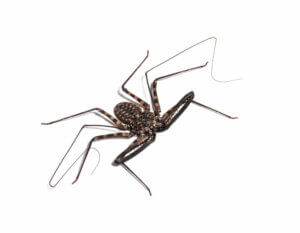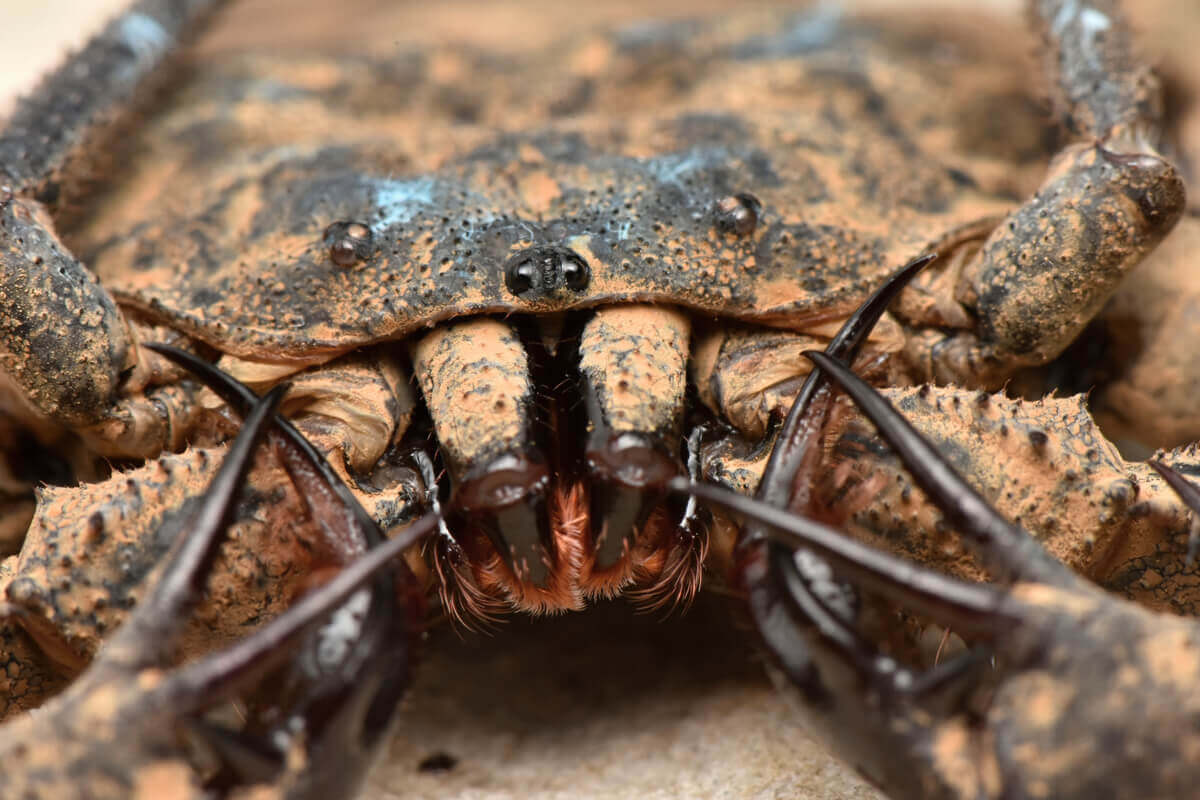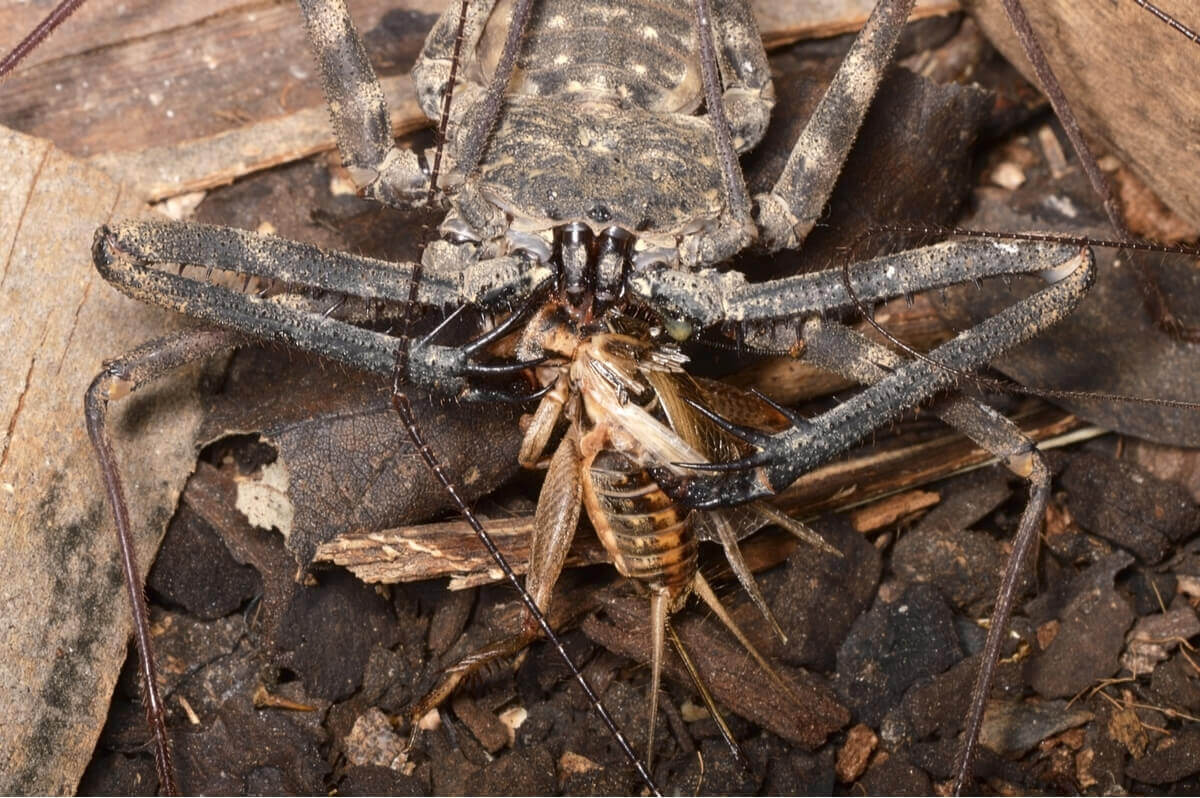Captive Care of Amblypygids (Whip Spider and Others)


Written and verified by the biologist Ana Díaz Maqueda
Although the whip spider may not look very friendly, lovers of arthropods appreciate this animal. They make good pets for those who like spiders or scorpions but fear being bitten or stung. Learn about the captive care of amblypygids today.
Amblypygids are tropical climate animals. Thus, their enclosure must meet specific physicochemical parameters. This isn’t like breeding crickets, as whip spiders have some more demanding needs. Below, we’ll tell you all about captive care for amblypygids.
Initial considerations
Certain species of amblypygids, such as Charinus seychellarum or Phrynichus scaber, are considered Vulnerable (VU) by the International Union for Conservation of Nature (IUCN). Therefore, you must make sure that the animal you bought came from captive breeding and wasn’t removed from the wild.
Similarly, these animals breed easily and adapt to different climates. For this reason, you should prevent escapes at all times and never consider deliberately releasing them into the wild.
Due to their way of life, these animals require specific terrariums with certain parameters that must be met for the arthropod to survive. If you don’t meet an amblypygid’s specific needs, the animal will die.
Unlike other arthropods, these invertebrates are very peaceful and calm. You can handle them without fearing harm. However, they’re very fast and could easily escape. For this reason, we recommend only handling them (when necessary) with a pot. For example, when you’re going to clean their terrarium.

Captive care of amblypygids
Amblypygids are expert escape artists. Thanks to their flat bodies, these arthropods can slip into very small cracks. For this reason, when choosing an enclosure for this animal, you have to consider its incredible adaptability.
Captive care of amblypygids: the perfect terrarium
Despite the fact that the body of amblypygids isn’t very big (about 1.5 inches), their legs can make them measure more than seven inches in leg span. This, along with the fact that they’re really active animals, means that they require at least a 20-liter volume terrarium for a single animal.
If you want to introduce more than one specimen, you have to increase the terrarium capacity by 10 liters per specimen. Also, it’s important for the tank to be vertical, meaning taller than wider.
Amblypygids are arboreal animals. Thus, it’s essential to place trunks and high branches in the terrarium. In addition, like all arthropods, amblypygids shed their exoskeleton from time to time. To do so, they hang themselves from high places. If there aren’t any high places to hang from, the animal can’t shed its skin or it’ll do so poorly, leading to its death.
The substrate must have a minimum depth of 4.7 inches and it must always be moist but never waterlogged. The best type of substrate for these animals is coconut fiber, since it stays moist but also ventilates, preventing the appearance of fungi. You can also place live plants inside the terrarium to add a tropical touch.
Finally, you have to place many hiding places, as this is a nocturnal species that hates light. The best options are cork logs that you should place vertically. If you’re going to place rocks, make sure you fix them well so they’re stable, to avoid possible crushing.
Environmental parameters
Although they come from tropical climates, these animals are actually nocturnal. Thus, they spend the day hiding in humid and cool cracks. These animals don’t require a heater.
However, it’s best to place the terrarium in a cool place inside your house that doesn’t get direct sunlight. Also, make sure that any heat source, such as a radiator, is turned off in the room you place it in. But there’s no need to worry. Nothing will happen to your pet if the temperature occasionally rises above 86°F.
The single most demanding environmental parameter for this species is humidity. The relative humidity must always be above 75% in the enclosure. For this purpose, spray the tank daily with a sprayer. But make sure not to water-log the substrate!
Captive care of amblypygids: feeding
Amblypygids are insectivores. They’re very good at controlling cockroach pests, which is why many people let them roam free inside their homes.
You must feed these invertebrates live prey such as crickets (Acheta domesticus) or cockroaches (Blatta lateralis). Amblypygids are silent predators. Thus, they keep an eye on their prey and stay totally still until they’re close enough to catch it with their prehensile tails. This behavior is fascinating.
Something important that you must take into account when this animal is shedding is that, after it does it, it’s totally vulnerable. The crickets and cockroaches that are normally their prey will become predators at this time if you don’t remove them from the terrarium.

As you can see, amblypygids are very easy to care for. Even so, most of the deaths are due to one specific parameter: humidity. If you keep this value at optimal levels, your amblypygid will thrive.
Although the whip spider may not look very friendly, lovers of arthropods appreciate this animal. They make good pets for those who like spiders or scorpions but fear being bitten or stung. Learn about the captive care of amblypygids today.
Amblypygids are tropical climate animals. Thus, their enclosure must meet specific physicochemical parameters. This isn’t like breeding crickets, as whip spiders have some more demanding needs. Below, we’ll tell you all about captive care for amblypygids.
Initial considerations
Certain species of amblypygids, such as Charinus seychellarum or Phrynichus scaber, are considered Vulnerable (VU) by the International Union for Conservation of Nature (IUCN). Therefore, you must make sure that the animal you bought came from captive breeding and wasn’t removed from the wild.
Similarly, these animals breed easily and adapt to different climates. For this reason, you should prevent escapes at all times and never consider deliberately releasing them into the wild.
Due to their way of life, these animals require specific terrariums with certain parameters that must be met for the arthropod to survive. If you don’t meet an amblypygid’s specific needs, the animal will die.
Unlike other arthropods, these invertebrates are very peaceful and calm. You can handle them without fearing harm. However, they’re very fast and could easily escape. For this reason, we recommend only handling them (when necessary) with a pot. For example, when you’re going to clean their terrarium.

Captive care of amblypygids
Amblypygids are expert escape artists. Thanks to their flat bodies, these arthropods can slip into very small cracks. For this reason, when choosing an enclosure for this animal, you have to consider its incredible adaptability.
Captive care of amblypygids: the perfect terrarium
Despite the fact that the body of amblypygids isn’t very big (about 1.5 inches), their legs can make them measure more than seven inches in leg span. This, along with the fact that they’re really active animals, means that they require at least a 20-liter volume terrarium for a single animal.
If you want to introduce more than one specimen, you have to increase the terrarium capacity by 10 liters per specimen. Also, it’s important for the tank to be vertical, meaning taller than wider.
Amblypygids are arboreal animals. Thus, it’s essential to place trunks and high branches in the terrarium. In addition, like all arthropods, amblypygids shed their exoskeleton from time to time. To do so, they hang themselves from high places. If there aren’t any high places to hang from, the animal can’t shed its skin or it’ll do so poorly, leading to its death.
The substrate must have a minimum depth of 4.7 inches and it must always be moist but never waterlogged. The best type of substrate for these animals is coconut fiber, since it stays moist but also ventilates, preventing the appearance of fungi. You can also place live plants inside the terrarium to add a tropical touch.
Finally, you have to place many hiding places, as this is a nocturnal species that hates light. The best options are cork logs that you should place vertically. If you’re going to place rocks, make sure you fix them well so they’re stable, to avoid possible crushing.
Environmental parameters
Although they come from tropical climates, these animals are actually nocturnal. Thus, they spend the day hiding in humid and cool cracks. These animals don’t require a heater.
However, it’s best to place the terrarium in a cool place inside your house that doesn’t get direct sunlight. Also, make sure that any heat source, such as a radiator, is turned off in the room you place it in. But there’s no need to worry. Nothing will happen to your pet if the temperature occasionally rises above 86°F.
The single most demanding environmental parameter for this species is humidity. The relative humidity must always be above 75% in the enclosure. For this purpose, spray the tank daily with a sprayer. But make sure not to water-log the substrate!
Captive care of amblypygids: feeding
Amblypygids are insectivores. They’re very good at controlling cockroach pests, which is why many people let them roam free inside their homes.
You must feed these invertebrates live prey such as crickets (Acheta domesticus) or cockroaches (Blatta lateralis). Amblypygids are silent predators. Thus, they keep an eye on their prey and stay totally still until they’re close enough to catch it with their prehensile tails. This behavior is fascinating.
Something important that you must take into account when this animal is shedding is that, after it does it, it’s totally vulnerable. The crickets and cockroaches that are normally their prey will become predators at this time if you don’t remove them from the terrarium.

As you can see, amblypygids are very easy to care for. Even so, most of the deaths are due to one specific parameter: humidity. If you keep this value at optimal levels, your amblypygid will thrive.
All cited sources were thoroughly reviewed by our team to ensure their quality, reliability, currency, and validity. The bibliography of this article was considered reliable and of academic or scientific accuracy.
- Gerlach, J. 2014. Charinus seychellarum. The IUCN Red List of Threatened Species 2014: e.T196517A2458903.
- Gerlach, J. 2014. Phrynichus scaber. The IUCN Red List of Threatened Species 2014: e.T196520A2458910.
- Unknown. (2020). Care guide Australian Amblypygid, Charinus pescotti. Minibeast Wildlife.
- Unknown. (2016). Whip Spider Care (Amblypygi sp.). Backwater Reptiles Blog. Disponible en: https://backwaterreptilesblog.com/care-whip-spider-amblypygi-sp/
This text is provided for informational purposes only and does not replace consultation with a professional. If in doubt, consult your specialist.








